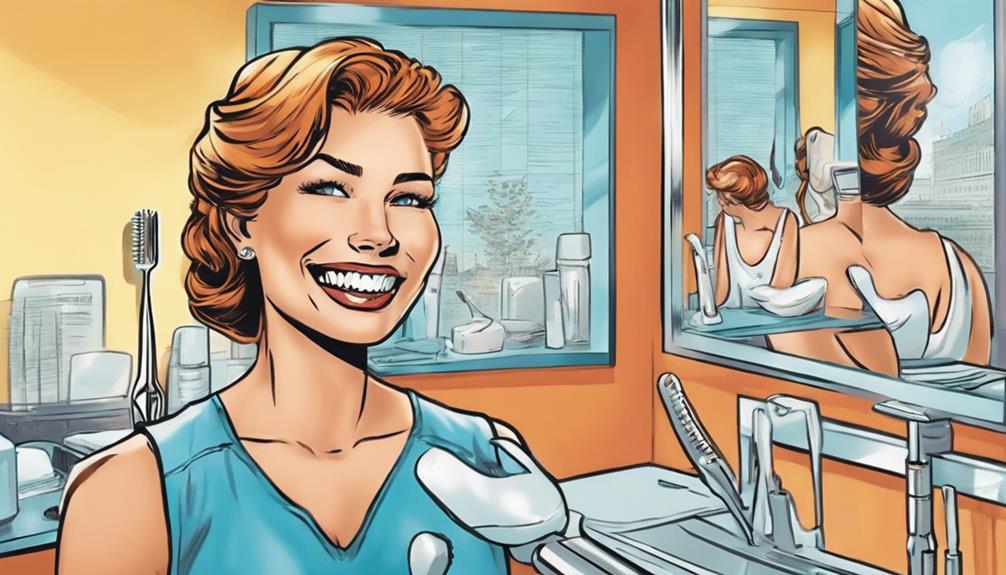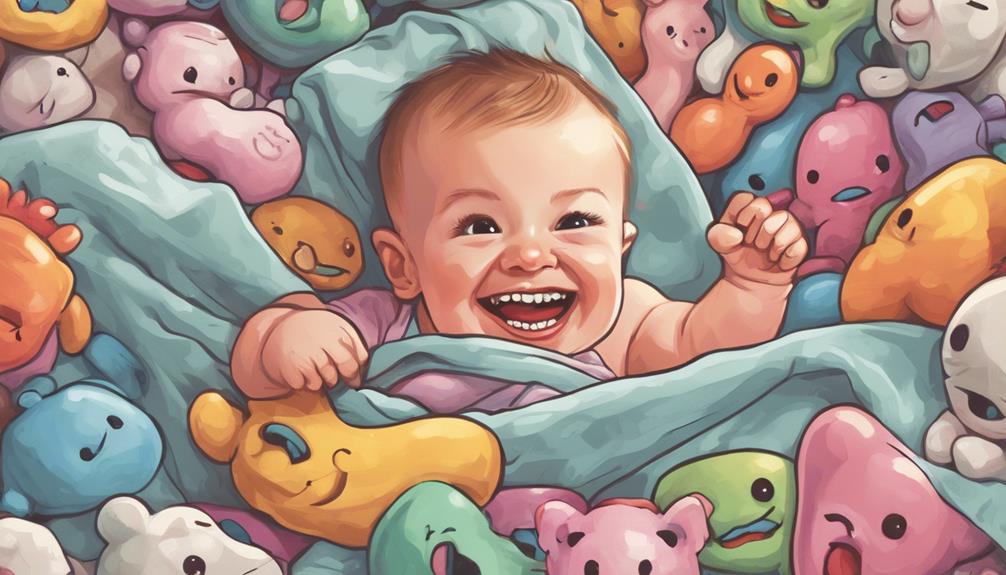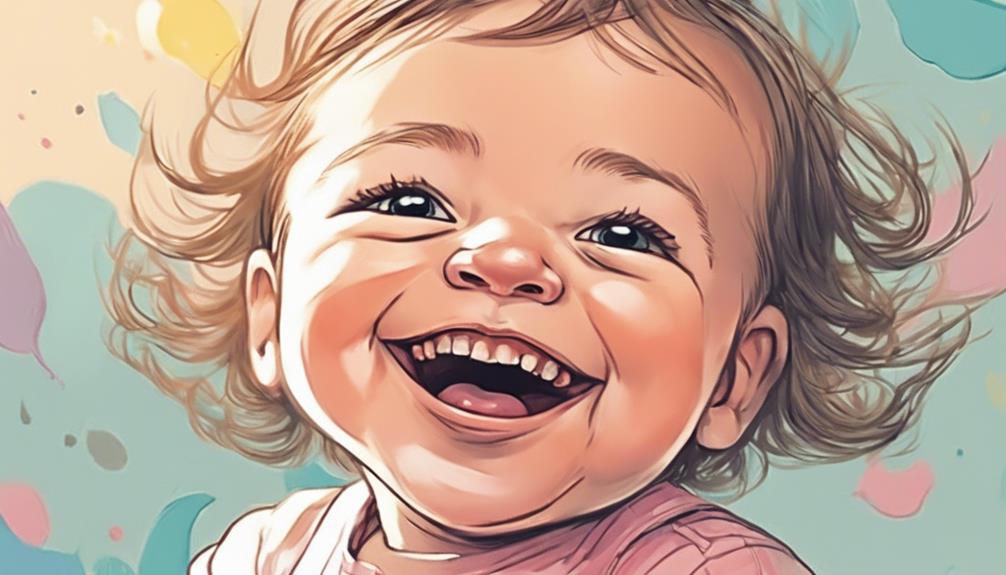Babies can be born with teeth, known as natal teeth, due to a mix of genetic factors and disruptions in normal tooth development during pregnancy. These rare teeth usually show up as small, underdeveloped structures—often the lower central incisors. Environmental influences, like maternal nutrition and health, can also play a role. Additionally, certain medical conditions may increase the chance of natal teeth. While they're not usually a cause for alarm, they can lead to feeding issues or dental concerns. If you want to discover more about their implications or care, keep exploring the topic further.
Key Takeaways
- Natal teeth, occurring in about 1 in 2,000 to 3,000 births, are rare and usually linked to genetic factors.
- They often manifest as small, underdeveloped teeth, primarily affecting lower central incisors with weak structures.
- Environmental influences, like maternal health and nutritional deficiencies, may disrupt normal tooth development in infants.
- Associated conditions include cleft lip/palate and Sotos syndrome, indicating a genetic predisposition in some cases.
Overview of Natal Teeth
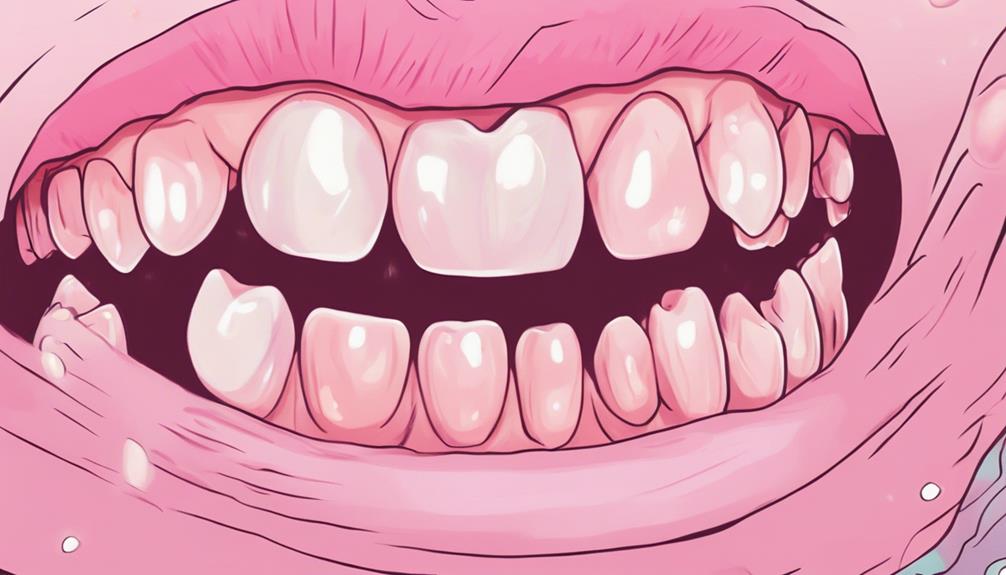
Natal teeth are rare dental anomalies that can surprise new parents, appearing in about 1 in every 2,000 to 3,000 births. These teeth usually manifest as small, cone-shaped structures, mainly affecting the lower central incisors. You might notice that they often have weak structures and can be loosely attached due to underdeveloped roots.
While the exact cause of natal teeth remains unclear, research suggests a link to genetic factors and certain medical conditions like cleft lip and palate, as well as Sotos syndrome.
If your baby is born with natal teeth, it's vital to monitor them closely. Complications can arise, particularly if these teeth are loose or improperly formed. Feeding difficulties may occur, and there's an increased risk of aspiration, which can be dangerous.
Diagnosing natal teeth generally involves a physical examination, and your pediatrician might recommend X-ray imaging to assess their structure. Understanding the potential need for removal to prevent complications is important in ensuring your baby's safety and health.
Differences Between Natal and Neonatal Teeth
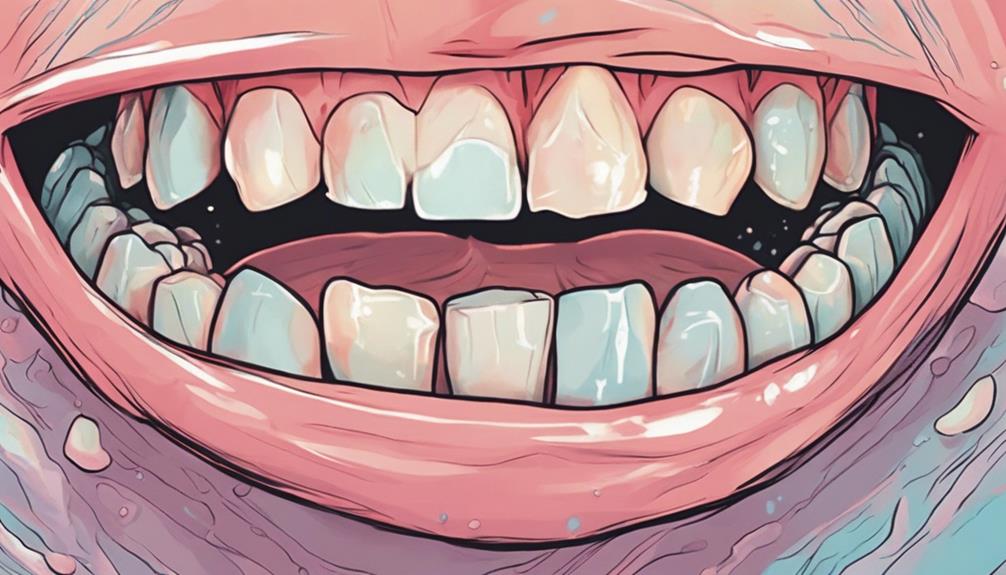
When you think about natal and neonatal teeth, it's important to understand their key differences.
Natal teeth are present at birth, while neonatal teeth emerge within the first month of life.
Recognizing these distinctions can help you better navigate any dental concerns that may arise.
Definition of Natal Teeth
Teeth present at birth, known as natal teeth, differ from neonatal teeth, which erupt within the first month of life. Natal teeth occur in about 1 in 2,000 to 3,000 live births and are typically found in the lower jaw. These teeth often resemble underdeveloped primary teeth, featuring small size, hypoplastic enamel, and weak roots that can lead to complications.
The main distinction between natal and neonatal teeth lies in their timing. Natal teeth are visible at birth, while neonatal teeth emerge shortly after. Both types of teeth can present similar dental concerns, such as feeding difficulties and an increased risk of aspiration, but natal teeth are usually recognized right after delivery.
Because of their mobility and cone-shaped appearance, natal teeth require careful monitoring to prevent issues like irritation or injury to the infant's tongue or gums.
Understanding these differences is essential for new parents and caregivers to guarantee the appropriate care and attention for their newborn's dental health. By recognizing what natal teeth are and how they differ from neonatal teeth, you'll be better prepared to address any potential concerns.
Timing of Tooth Eruption
Understanding the timing of tooth eruption helps clarify the differences between natal and neonatal teeth, with the former being present at birth and the latter appearing within the first month.
Natal teeth are quite rare, occurring in about 1 in 2,000 to 3,000 births. These teeth typically manifest as lower central incisors and may be underdeveloped or mobile. On the other hand, neonatal teeth can emerge in various positions within the mouth and usually erupt within the first 30 days after birth.
You might notice that some infants have their first teeth sprout as early as four weeks old. Unlike natal teeth, neonatal teeth tend to have more developed roots, making them less likely to cause immediate complications.
This distinction in timing and development can help you understand how these teeth impact your baby's oral health. If your baby has natal or neonatal teeth, it's crucial to monitor them closely and consult with a pediatric dentist.
Knowing the differences between these types of teeth can aid in ensuring your little one has a healthy start with their first teeth.
Causes of Natal Teeth
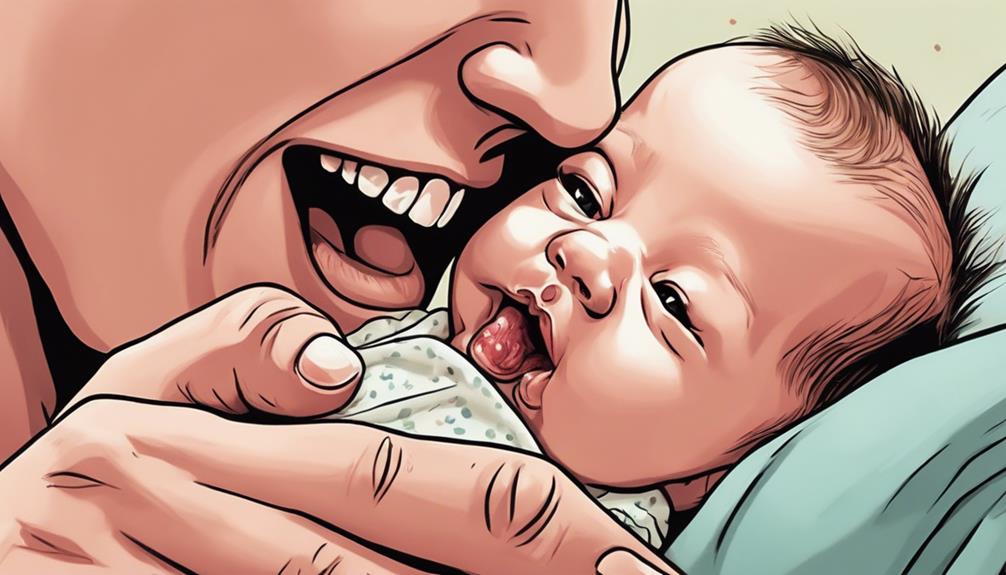
When it comes to the causes of natal teeth, genetic factors often play a significant role.
You might also find that certain medical conditions and environmental influences contribute to their development.
Understanding these points can help clarify why some babies are born with teeth while others aren't. One factor that can contribute to babies being born with teeth is genetics, as some families may have a higher likelihood of passing on this trait. Additionally, certain medical conditions or medications taken by the mother during pregnancy can also play a role in the development of teeth in utero. For toothless babies, it’s important to provide appropriate nutrition and care, including feeding them soft foods for toothless babies to ensure they receive the necessary nutrients for healthy growth and development.
Genetic Factors Involved
Genetic factors considerably influence the likelihood of natal teeth, with around 15% of affected infants having a family history of the condition. This genetic predisposition suggests that if you or your partner have experienced natal teeth, your child may be more likely to have them too.
Studies show that higher incidences of natal teeth are often associated with specific genetic syndromes, such as Sotos syndrome, Ellis-van Creveld syndrome, and Hallermann-Streiff syndrome.
Interestingly, females have a higher statistical likelihood of being born with natal teeth compared to males, hinting at a potential genetic influence on their development. Irregularities in dentin formation, which can be hereditary, also contribute to the presence of natal teeth at birth. This means that if there are issues in how dentin—the tissue beneath the enamel—is formed, it could lead to teeth developing earlier than expected.
While environmental factors and nutritional deficiencies during pregnancy may play a role, the core genetic factors remain a critical focus in understanding why some babies are born with teeth. Knowing this can help you prepare for any dental surprises with your newborn.
Associated Medical Conditions
Certain medical conditions, like cleft lip and palate, can increase the chances of a baby being born with natal teeth. These conditions often affect the development of oral structures, leading to the early eruption of teeth.
Genetic factors also play a significant role; around 15% of infants with natal teeth have a family history of the same. This suggests that if someone in your family had natal teeth, your baby might be more likely to have them too.
Additionally, specific syndromes, such as Sotos syndrome, Hallermann-Streiff syndrome, and Ellis-van Creveld syndrome, have been linked to the occurrence of natal teeth.
Curiously, research indicates that females are statistically more likely to be born with these teeth compared to males, hinting at a possible gender predisposition.
While these medical conditions and genetic factors are significant, it's important to remember that other elements may contribute to the development of natal teeth.
As a parent, staying informed about these associations can help you understand any potential dental issues your baby may face.
Environmental Influences Considered
Exploring environmental influences reveals that factors like nutritional deficiencies and maternal health conditions during pregnancy can contribute to the development of natal teeth.
It's important to understand how these influences interact with genetic factors, as they may play a significant role in this phenomenon.
- Nutritional deficiencies during pregnancy
- Maternal infections or hormonal imbalances
- Exposure to environmental toxins
- Family history of natal teeth
When a mother experiences nutritional deficiencies, it can directly affect fetal development, including tooth formation.
Additionally, health conditions such as infections or hormonal issues may disrupt normal tooth development.
Exposure to certain environmental toxins or chemicals during pregnancy has also been suggested as a potential culprit in abnormal tooth formation.
Curiously, genetic factors can further complicate things; studies have shown that up to 62% of cases involve a family history of natal teeth.
Ultimately, while the exact cause remains unclear, the combination of environmental influences and genetic factors during pregnancy likely contributes to the occurrence of natal teeth in some infants.
Risk Factors and Associated Conditions

Natal teeth are often linked to specific risk factors and associated conditions, making their occurrence an intriguing aspect of neonatal health. You might be surprised to learn that these teeth appear in about 1 in 2,000 to 3,000 live births, highlighting their rarity.
Infants with congenital conditions, particularly cleft lip and palate or Sotos syndrome, show a higher prevalence of natal teeth. If you have a family history of natal teeth, it increases the likelihood of your baby being born with them. Research indicates that around 15% of infants with this condition have relatives who've also experienced it.
Interestingly, gender may also play a role, as females are statistically more prone to being born with natal teeth than males.
Genetic factors, malnutrition during pregnancy, and various environmental influences can contribute to their development in newborns. If you're an expectant parent, being aware of these risk factors and associated conditions can help you understand the nuances of your baby's dental health.
While natal teeth are uncommon, recognizing these correlations can provide useful insights into your child's overall wellbeing.
Characteristics of Natal Teeth

Natal teeth often look like small, underdeveloped primary teeth, usually appearing as lower central incisors at birth.
You might notice their unique cone-shaped appearance, irregular shapes, or discoloration, which can affect their function.
Understanding where these teeth commonly occur and the potential complications they can cause is essential for managing your baby's oral health.
Appearance and Structure
Often, babies born with teeth have small, cone-shaped structures that resemble underdeveloped primary incisors. These natal teeth look quite distinct, primarily appearing as single lower central incisors. You might notice some unique features about them:
- Size: Typically small and may seem disproportionately tiny compared to other teeth.
- Shape: Cone-shaped, giving them a distinctive appearance.
- Mobility: Often mobile because they lack proper root structure, being attached only by soft tissue.
- Discoloration: They can present brown or yellow hues, indicating enamel defects.
Most often, you'll see one lower front tooth, but in rare cases, multiple natal teeth can appear. Molar natal teeth are extremely uncommon at birth.
Understanding these characteristics helps demystify the phenomenon of natal teeth and allows parents to prepare for any necessary dental considerations. If you notice these features in your newborn, it's a good idea to consult a pediatric dentist for a thorough evaluation.
Common Locations Found
Most commonly, you'll find these teeth in the lower jaw, specifically as lower central incisors, though they can occasionally appear in the upper jaw as well.
Natal teeth are quite rare, occurring in about 1 in 2,000 to 3,000 births. When they do appear, they often exhibit distinct characteristics. You'll notice that these teeth tend to be smaller than typical baby teeth and have a cone-shaped appearance. Sometimes, you might see discoloration, such as brown or yellow hues, which can make them stand out even more.
It's also important to keep in mind that natal teeth often lack fully developed roots. This means they might be loosely attached to the gums, making them prone to movement or even removal.
While you might expect to see only one natal tooth, multiple teeth can occur, but that's considered a rarity.
Potential Complications Involved
The presence of natal teeth can lead to various complications, including feeding difficulties and increased irritation to your baby's tongue. These teeth often have underdeveloped roots, making them prone to looseness and mobility.
As a parent, you might encounter several issues related to these natal teeth:
- Feeding difficulties: Natal teeth can cause discomfort while breastfeeding or during bottle feeding.
- Irritation: The sharp edges of the teeth may irritate your baby's tongue and gums.
- Aspiration risk: Loose natal teeth can pose a risk of aspiration, especially if they dislodge during feeding.
- Enamel defects: Some natal teeth may have enamel hypoplasia, leading to a higher susceptibility to cavities.
It's vital to monitor your baby's oral health closely if natal teeth are present. Consulting with a pediatric dentist can help address any potential complications and guarantee proper care.
Potential Complications
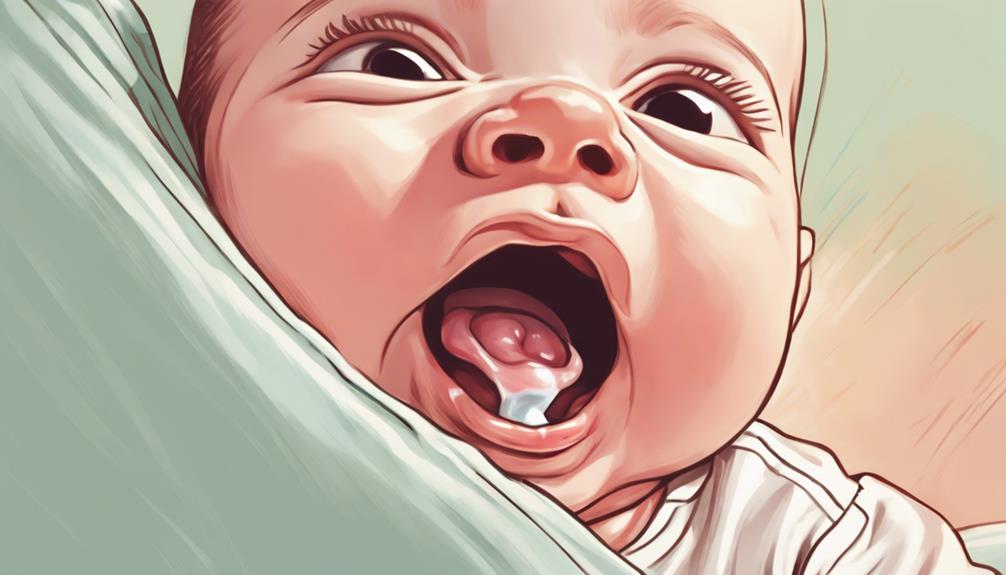
Natal teeth can lead to several complications that may impact both the infant's health and the parents' peace of mind. These teeth, while often seen as a novelty, can create serious issues. For instance, loose natal teeth pose a risk of aspiration, which can obstruct the airway. Feeding difficulties may also arise; sharp edges can injure the infant's tongue or gums during breastfeeding, making feeding a painful experience.
Here's a quick overview of potential complications:
| Complication | Description |
|---|---|
| Aspiration Risk | Loose teeth may be inhaled, causing airway issues. |
| Feeding Difficulties | Sharp edges can injure the infant while breastfeeding. |
| Psychological Stress | Parents may worry about the health implications. |
| Long-term Dental Issues | Potential for cavities due to enamel defects. |
Parents should monitor their baby's oral health closely. If you notice any signs of irritation or injury in the mouth, consulting a pediatric dentist can help manage symptoms effectively. Understanding these complications can help you better prepare for and address any challenges that arise with natal teeth.
Diagnosis of Natal Teeth

When evaluating potential complications from natal teeth, a thorough diagnosis is key to understanding their implications for your baby's health. You'll want to verify that a healthcare professional conducts a physical examination, as this typically reveals visible teeth in your infant's mouth, often in the lower jaw.
Key aspects of the diagnosis include:
- Reviewing your baby's medical history for familial occurrences of natal teeth.
- Analyzing any associated syndromes.
- Utilizing X-ray imaging to evaluate root structures and overall tooth development.
- Confirming diagnosis through the appearance of discolored and underdeveloped teeth.
Treatment Options for Natal Teeth
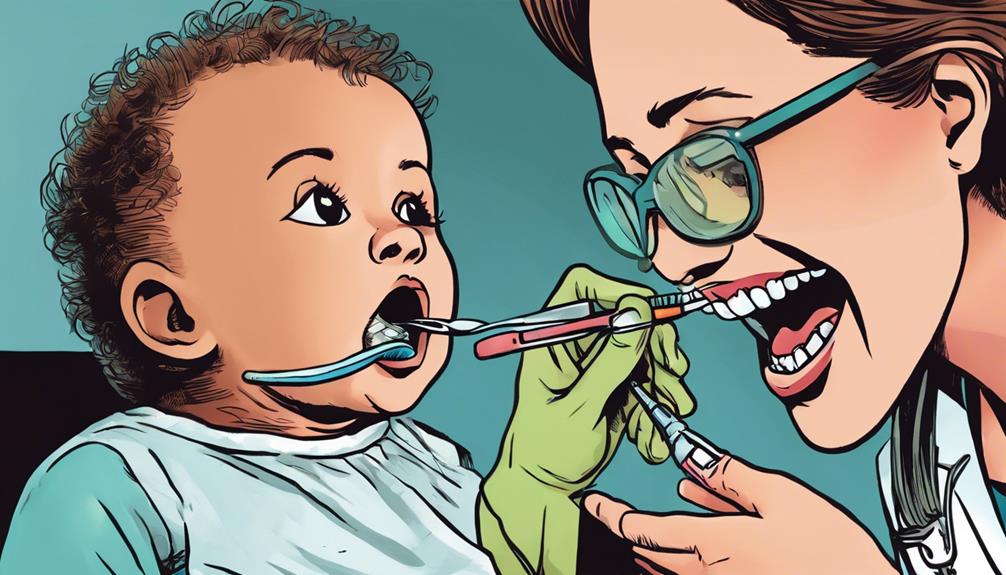
Monitoring the condition of natal teeth is vital, as most cases require little to no intervention unless complications arise. If you notice that your baby's natal teeth are loose or lack proper root structure, it's important to consult a pediatric dentist. They might recommend surgical removal to prevent feeding difficulties or potential choking hazards.
Your pediatric dentist may use dental x-rays to evaluate the root structure and determine whether extraction is necessary based on the tooth's stability and associated risk factors. For natal teeth that are firmly attached and not causing issues, regular dental check-ups and monitoring are typically sufficient to guarantee your baby's dental health remains on track.
It's also important to educate yourself about proper oral hygiene for your baby. Keep an eye out for any signs of irritation or complications, such as redness or swelling around the gums. By staying vigilant and maintaining open communication with your pediatric dentist, you can effectively manage your child's natal teeth and address any concerns that may arise.
Ultimately, most cases will resolve without intervention, allowing your little one to thrive.
Myths and Misconceptions

Understanding the realities behind natal teeth can help dispel common myths and misconceptions that often surround their occurrence. If you have a baby with natal teeth, it's crucial to separate fact from fiction.
Here are some common myths:
- Natal teeth indicate good health: Their presence is random and not a sign of overall wellness.
- All natal teeth will fall out: This isn't guaranteed; some may require dental assessment for removal.
- They're linked to health issues: While some syndromes show higher incidences, most natal teeth aren't associated with significant medical conditions.
- Natal teeth are always well-formed: They can vary in size, shape, and strength, often appearing small and weak.
When to Consult a Dentist
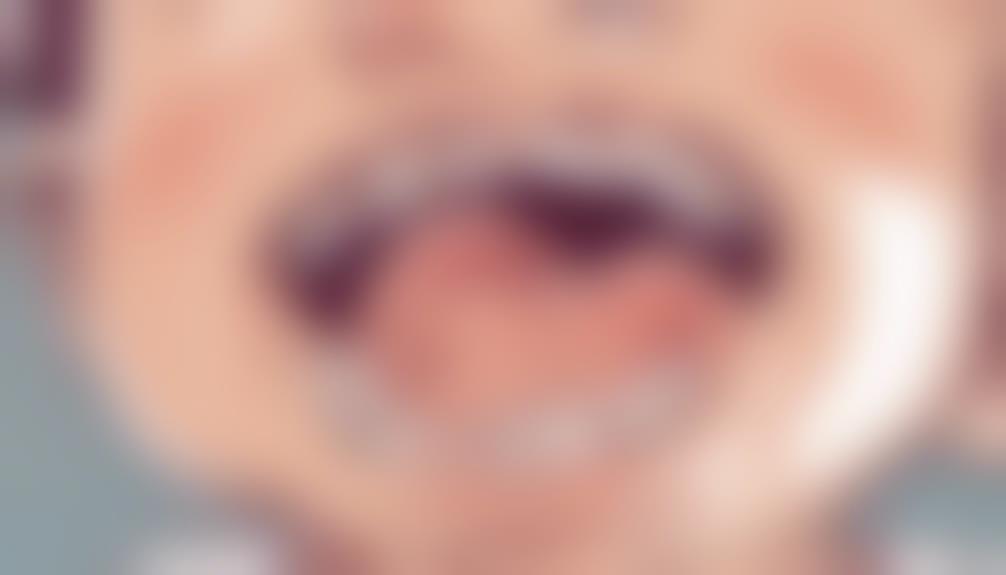
Consult a dentist if your baby's natal teeth seem loose, as they might pose a choking hazard during feeding. It's important to stay vigilant for any signs that could indicate a problem. If your little one experiences discomfort or irritation due to sharp edges, don't hesitate to seek dental advice.
Here are some key indicators that suggest you should consult a dentist:
| Signs to Watch For | Action Needed |
|---|---|
| Loose natal teeth | Consult a dentist immediately |
| Discomfort or irritation | Seek dental advice promptly |
| Swelling or redness | Monitor closely, contact a dentist |
| Excessive drooling | Evaluate for potential infection |
| Feeding difficulties | Consult a pediatric dentist |
Regular dental check-ups are vital to monitoring the development and health of natal teeth. These visits allow you to discuss any concerns you may have with a qualified professional. Remember, addressing any issues early on can help guarantee your baby's dental health remains on track. Don't wait; consult a dentist if you notice any concerning signs!
Frequently Asked Questions
What Causes a Baby to Be Born With Teeth?
Natal teeth can result from genetic factors, malnutrition during pregnancy, and environmental influences. You might also notice that certain medical conditions and family history play a role in whether a baby is born with teeth.
Is It Possible to Give Birth to a Baby With Teeth?
Yes, it's possible for a baby to be born with teeth. This rare occurrence, known as natal teeth, affects about 1 in 2,000 to 3,000 births, and usually involves small, less stable teeth in the lower jaw.
What Causes Babies to Get Teeth Early?
When teeth burst forth like tiny stars in a baby's mouth, it's often due to genetic factors, environmental influences, or irregular dental development. These elements dance together, causing some babies to get teeth earlier than expected.
Why Are Humans Born With Baby Teeth?
Humans are born with baby teeth to help with the initial stages of eating and speech development. These teeth create a foundation for proper alignment and function, supporting healthy oral growth as you age.
What Are the Possible Reasons for Babies Being Born With Teeth?
Babies born with teeth, also known as natal teeth, may be due to genetic factors or certain medical conditions. In some cases, it may be linked to hormonal imbalances or excess calcium levels in the mother during pregnancy. However, the exact cause of babies being born with teeth is not always clear.
Can Babies Being Born With Teeth Affect Their Teething Process?
Babies being born with teeth can impact the understanding baby teething process. It may cause discomfort as the other teeth come in. However, it doesn’t necessarily speed up or alter the overall teething process. Parents should still be prepared to help soothe their baby’s discomfort as their teeth come in.
Can Babies’ Teething Cause Them to Be Born With Teeth?
Babies’ teething is a natural process that occurs around 6 months old. While some babies are born with teeth, it is not directly linked to teething. The presence of teeth at birth is a rare genetic condition. Doctors are the best resource for understanding why babies teeth and any concerns about their dental development.
Is the Delayed Arrival of Baby Teeth Related to the Possibility of Babies Being Born with Teeth?
The delayed arrival of baby teeth, also known as late baby teeth development, is not necessarily related to the possibility of babies being born with teeth. Late baby teeth development can be influenced by a variety of factors, such as genetics, nutrition, and overall dental health. It is important for parents to monitor their child’s dental development and consult with a pediatric dentist if they have any concerns.
Conclusion
In summary, while natal teeth may seem startling, they're often just a quirky quirk of nature.
Understanding their causes and characteristics helps ease any worries.
If your little one has these tiny teeth, don't hesitate to seek a savvy specialist.
With the right care, you can guarantee their smile sparkles brilliantly.
Embrace this fascinating facet of your baby's development, and remember, each tooth is a tiny tribute to their unique journey into the world!
